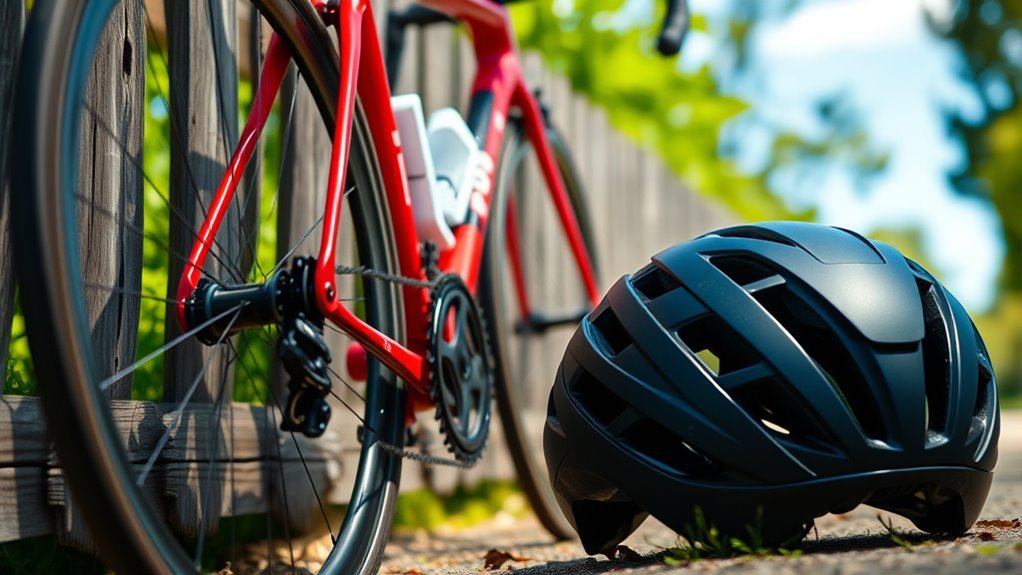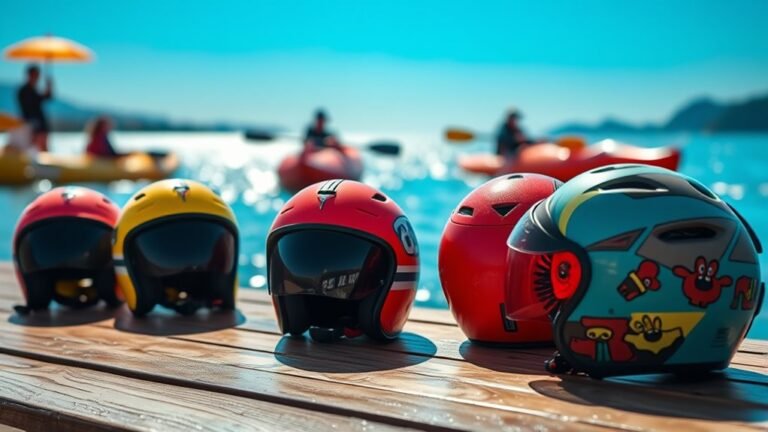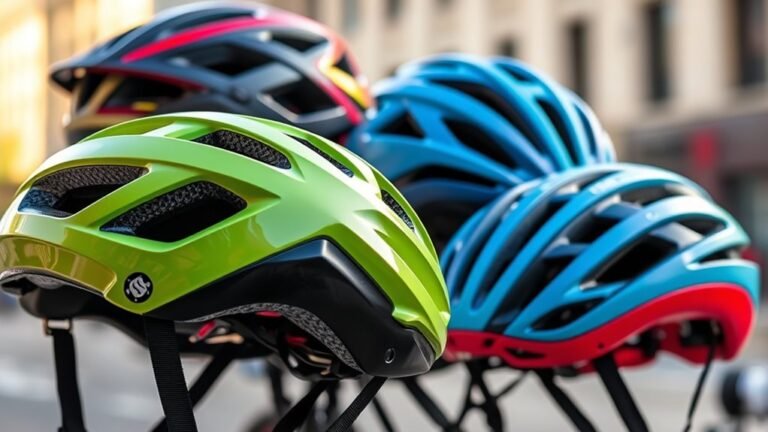How to Choose a Helmet That Complements Your Bike
To choose a helmet that complements your bike, start by ensuring it meets safety standards like CPSC or Snell. Measure your head for the right fit and select a style that suits your riding type—whether it’s road, mountain, or commuter. Look for features like effective ventilation and adjustable straps for added comfort. Don’t forget to coordinate colors and patterns with your bike for a cohesive look. There’s more to discover about selecting the perfect helmet.
Understanding Helmet Safety Standards

When you’re choosing a bike helmet, understanding safety standards is essential to guarantee your protection on the road. Look for helmets that meet helmet certification requirements, which confirm they’ve undergone rigorous testing for safety. These certifications come from organizations like CPSC, Snell, or ASTM, validating that the helmet can withstand specific impacts.
Impact resistance is another important factor; a helmet with high resistance can greatly reduce the risk of injury during a crash. Check for features such as multi-density foam and reinforced structures that enhance this protection. Remember, a certified helmet isn’t just about compliance; it’s about empowering your ride—allowing you to embrace the freedom of biking while knowing you’re safeguarded against potential dangers. Choose wisely, ride freely.
Assessing the Right Fit for Comfort and Security
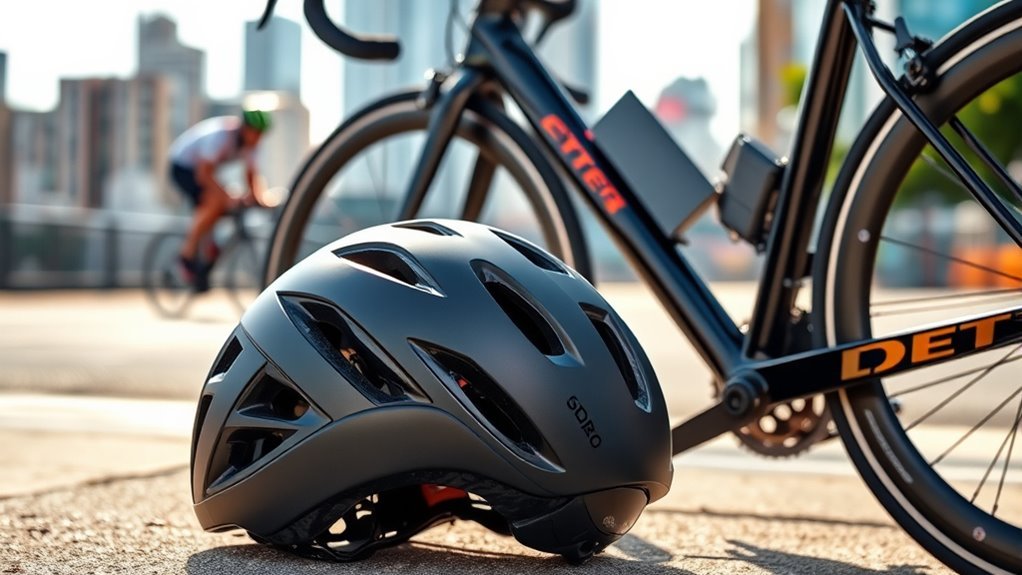
Finding the right fit for your bike helmet is essential, as a well-fitted helmet not only enhances comfort but also maximizes safety. Start by measuring your head circumference, then choose a helmet that matches your size. Look for fit adjustments like dial systems or padding that can help customize the fit for your unique shape. Verify the helmet sits level on your head, with the front just above your eyebrows. Pay attention to helmet materials; lightweight options can provide comfort without sacrificing protection. A snug fit should allow for some movement, but it shouldn’t wobble. Remember, the better your helmet fits, the more secure you’ll feel as you embrace the freedom of the open road.
Exploring Different Helmet Styles and Designs
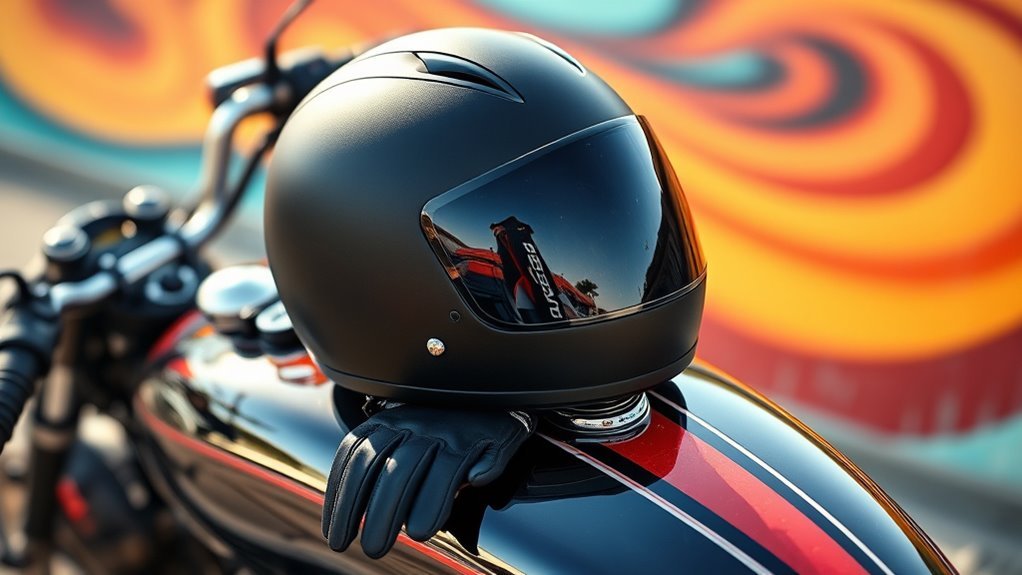
How do you choose the right style of bike helmet that fits your riding needs? Understanding the various helmet styles can enhance your ride while ensuring safety. Here are three popular options to take into account:
- Road Helmets: Lightweight with excellent ventilation, these helmets are designed for speed and long-distance rides. They often use advanced helmet materials to reduce weight without sacrificing safety.
- Mountain Bike Helmets: These offer more coverage and protection, ideal for rough terrains. They usually have enhanced ventilation to keep you cool during challenging rides.
- Commuter Helmets: Blend style and functionality, often featuring a sleek design with practical ventilation. They’re perfect for urban cyclists who want safety without compromising on aesthetics.
Choosing the right style will complement your bike and enhance your riding experience.
Features to Look for in a Functional Helmet
While selecting a functional helmet, it’s essential to contemplate several key features that enhance safety and comfort. First, look for effective ventilation systems that keep you cool during rides, especially on warm days. Adequate airflow not only improves comfort but also helps maintain focus on the road ahead. Next, consider weight considerations; a lightweight helmet reduces fatigue, allowing you to enjoy longer rides without discomfort. Additionally, prioritize impact resistance and adjustable straps for a secure fit. Always test the helmet’s snugness; it should feel comfortable without being too tight. By focusing on these features, you’ll guarantee that your helmet not only protects you but also allows you the freedom to ride with confidence and ease.
Coordinating Colors and Patterns With Your Bike
When it comes to coordinating colors and patterns with your bike, what’s your personal style? Choosing the right helmet isn’t just about safety; it’s also about expressing yourself. Here are some tips for effective color combinations and pattern matching:
- Complementary Colors: Pick a helmet color that contrasts nicely with your bike to create a striking look.
- Matching Patterns: If your bike has unique patterns, consider a helmet with subtle designs that echo these elements without overwhelming.
- Neutral Base: A helmet in a neutral shade can balance bold bike colors, ensuring everything looks cohesive.
Frequently Asked Questions
How Often Should I Replace My Helmet?
You should replace your helmet every three to five years, even if it looks fine. Over time, materials degrade, impacting helmet safety. If you’ve been in a crash, replace it immediately, regardless of visible damage. Always guarantee your helmet fits snugly; a proper fit enhances protection. Regularly check for wear and tear, and don’t compromise on safety. Keeping your helmet up to date guarantees you stay free to ride with confidence and security.
Can I Customize My Helmet With Stickers?
Sure, you can customize your helmet with stickers! After all, who wouldn’t want a helmet that screams “I’m a badass” while also protecting their noggin? Just be cautious during sticker application; make certain they don’t cover ventilation holes or compromise the helmet design. Remember, it’s all about balance—style and safety can coexist. Express yourself, but don’t let your creativity turn your helmet into a safety hazard. Your freedom’s worth it!
Are There Specific Helmets for Different Biking Disciplines?
Yes, there are specific helmets designed for different biking disciplines. For road cycling, you’ll want a lightweight helmet with excellent ventilation to keep you cool during long rides. Mountain biking helmets often feature extended coverage and visors to protect against debris and branches. Each type is tailored to the unique risks and requirements of the discipline, ensuring your safety and comfort while you enjoy the freedom of the open road or rugged trails.
What Materials Are Helmets Typically Made From?
Helmets are like a fortress for your head, built from durable materials. Typically, you’ll find them crafted with polycarbonate shells that provide strength and protection against impacts. Inside, foam liners absorb shock, ensuring comfort and safety during your rides. These materials work together to create a lightweight yet robust design, giving you the freedom to explore without fear. So, when choosing a helmet, consider how these components contribute to your overall safety.
Do Helmets Have Expiration Dates?
Yes, helmets do have expiration dates. Typically, they’re designed to last about 3 to 5 years, depending on usage and maintenance. Over time, the materials can degrade, impacting their ability to meet safety standards. To guarantee your helmet’s effectiveness, store it properly and avoid excessive exposure to sunlight or extreme temperatures. Regularly inspect it for any signs of damage, and if it’s been involved in a crash, replace it immediately for your safety.
